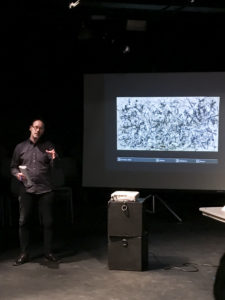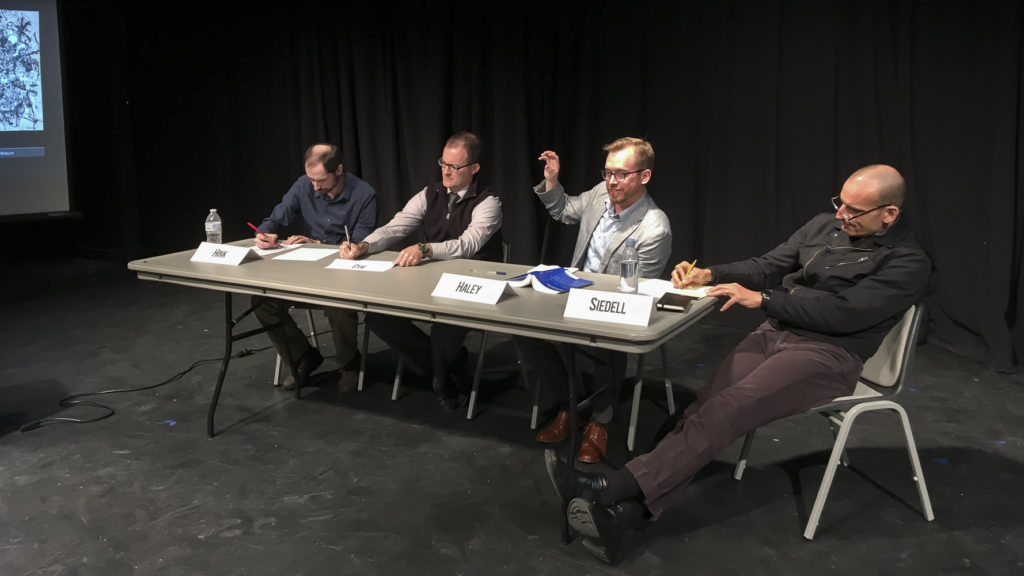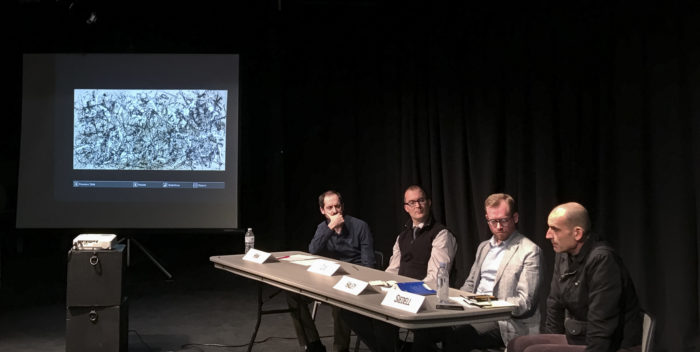Professors Lead Students in ‘Spelunking Plato’s Cave’
Professors Dr. Haley, Rev. Dr. Coe, and Dr. Hink discuss with author Dan Siedell during “Spelunking Plato’s Cave” panel in the Black Box Theatre. Photo by April Bayer
by April Bayer
Art historian and published author Dan Siedell recently returned to Concordia’s campus to join three Concordia professors in an art and philosophy panel titled “Spelunking Plato’s Cave.”
Faculty, students and community members gathered in the Black Box Theatre on the evening of April 2 to listen to panelists discuss and reflect on two artifacts: Plato’s “Allegory of the Cave” and Jackson Pollock’s “Autumn Rhythm.”
Panelists included Siedell, Assistant Professor of English Dr. Gabriel Haley, Assistant Professor of Theology Rev. Dr. David Coe, and Associate Professor of History Dr. John Hink. Professor of Art James Bockelman served as moderator.

Professor Jim Bockelman moderates the discussion between Siedell and Concordia professors. Photo by April Bayer.
“We’ve been talking, and actually I’ve been following (the panelists’) lead in the sense that they’re really interested in making academics an important part of Concordia since it is a college, it is a university,” Bockelman said. “In their own special way, they’ve all been trying to make that an important part of Concordia.”
While the three Concordia professors sitting on the stage were familiar to most students, several received their first introduction to Siedell and his work as an art scholar and critic at the King’s College in New York City.
Siedell, who first visited Concordia in 2017 to speak about the relationship between modern art and Christianity, selected “Autumn Rhythm” as a visual component to be considered alongside Hink’s chosen reading of Plato.
“My thought was to have a work that seemed to embrace what Plato finds problematic with poetry,” Siedell said. “The shadows, the fragments, the darkness, the chaos. And how a painting that from the very beginning seemed to forsake the values that had defined the history of Western painting: the good, true and the beautiful, the ideal.”
Bockelman began by giving each of the panel members three minutes to discuss their initial thoughts on the combination of Plato’s philosophy and Pollock’s art from their combined areas of expertise in art, literature, philosophy, history and theology.
Haley began by explaining how, for Plato, leaving the darkness and shadows of the cave is an allegory for education and the knowledge it provides of what reality truly is. Coe discussed the reactions he received when he shared the painting with his students, and Hink talked about the struggles of considering a text and piece of art that come into tension with one another.
“If you want to understand Plato’s piece especially, it’s about that dialogue,” Hink said. “It’s about orienting yourself towards something, ideally in the pursuit of truth. I think one of the virtues of something like this is participating in and watching that dialogue as we wrestle with these fundamental questions that we’ve been wrestling with for thousands of years.”

Dr. Gabriel Haley presents his thoughts on the relationship between Pollock’s work and Plato’s writing. Photo by April Bayer.
The rest of the event consisted of a dialogue between the panel and the audience. Panelists addressed several topics, including the question of how a person gains knowledge, how to escape the shadows of the world, and whether a work of art can or should be separated from a problematic artist.
Haley discussed how he manages to find peace and tranquility in a painting from an artist like Pollock, who struggled with relationships and alcoholism throughout his life.
“It has this almost tranquil atmosphere, the balancing of black and white and gray,” Haley said. “One of the things that Christianity does to classical tradition is it appreciates…its dissent and contemplation. It gives us the person of Christ, and it gives us the crucifixion as the most beautiful offering. There’s something we need, as humans, to focus on brokenness once in a while.”
Much of the closing conversation focused on how Christians can find hope in a fallen world.
Professor of Education and Psychology Dr. Russell Moulds shared some of his thoughts on the panel and whether flawed human creations like art and literature can help us truly understand eternity.
“In Ecclesiastes 3, (it says) ‘God has put eternity into our hearts such that we cannot understand it,’ so how do we access it?” Moulds said. “Plato and Pollock and the rest of us scratch our heads and wonder, ‘It’s there. How do we get at it?’ The words are not only inadequate, some would say they’re obstructions…(but) words get us there too, somehow or other. They certainly did with me when I stumbled across (Jesus).”














